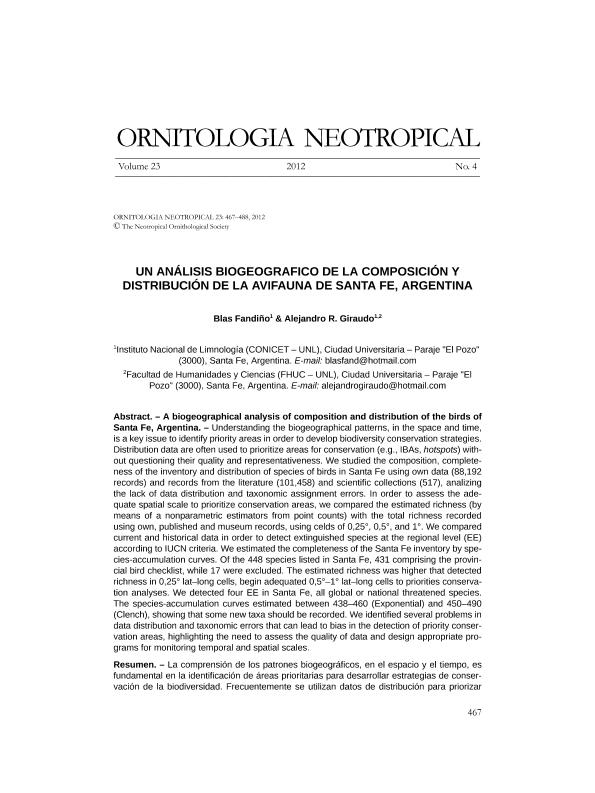Mostrar el registro sencillo del ítem
dc.contributor.author
Fandiño, Blas

dc.contributor.author
Giraudo, Alejandro Raul

dc.date.available
2020-03-25T20:20:09Z
dc.date.issued
2012-11
dc.identifier.citation
Fandiño, Blas; Giraudo, Alejandro Raul; Un Análisis Biogeografico de la Composición y Distribución de la Avifauna de Santa Fe, Argentina; Neotropical Ornithological Society; Ornitología Neotropical; 23; 4; 11-2012; 467-488
dc.identifier.issn
1075-4377
dc.identifier.uri
http://hdl.handle.net/11336/100781
dc.description.abstract
Understanding the biogeographical patterns, in the space and time, is a key issue to identify priority areas in order to develop biodiversity conservation strategies. Distribution data are often used to prioritize areas for conservation (e.g., IBAs, Hotspots) without questioning their quality and representativeness. We studied the composition, completeness of the inventory and distribution of species of birds in Santa Fe using own data (88,192 records) and records from the literature (101,458) and scientific collections (517), analizing the lack of data distribution and taxonomic assignment errors. In order to assess the adequate spatial scale to prioritize conservation areas, we compared the estimated richness (by means of a nonparametric estimators from point counts) with the total richness recorded using own, published and museum records, using celds of 0,25°, 0,5 °, and 1°. We compared current and historical data in order to detect extinguished species at the regional level (EE) according to IUCN criteria. We estimated the completeness of the Santa Fe inventory by species accumulation curves. Of the 448 species listed in Santa Fe, 431 comprising the provincial bird checklist, while 17 were excluded. The estimated richness was higher that detected richness in 0,25° lat?long cells, begin adequated 0,5°?1° lat?long cells to priorities conservation analyses. We detected four EE in Santa Fe, all global or national threatened species. The species accumulation curves estimated between 438?460 (Exponential) and 450?490 (Clench), showing that some new taxa should be recorded. We identified several problems in data distribution and taxonomic errors that can lead to bias in the detection of priority conservation areas, highlighting the need to assess the quality of data and design appropriate programs for monitoring temporal and spatial scales.
dc.format
application/pdf
dc.language.iso
spa
dc.publisher
Neotropical Ornithological Society

dc.rights
info:eu-repo/semantics/openAccess
dc.rights.uri
https://creativecommons.org/licenses/by-nc-sa/2.5/ar/
dc.subject
BIRDS
dc.subject
CHECKLIST AND DISTRIBUTION OF SPECIES
dc.subject
SPECIESACCUMULATION CURVES
dc.subject.classification
Conservación de la Biodiversidad

dc.subject.classification
Ciencias Biológicas

dc.subject.classification
CIENCIAS NATURALES Y EXACTAS

dc.title
Un Análisis Biogeografico de la Composición y Distribución de la Avifauna de Santa Fe, Argentina
dc.type
info:eu-repo/semantics/article
dc.type
info:ar-repo/semantics/artículo
dc.type
info:eu-repo/semantics/publishedVersion
dc.date.updated
2020-03-25T13:49:26Z
dc.journal.volume
23
dc.journal.number
4
dc.journal.pagination
467-488
dc.journal.pais
Canadá

dc.description.fil
Fil: Fandiño, Blas. Consejo Nacional de Investigaciones Científicas y Técnicas. Centro Científico Tecnológico Conicet - Santa Fe. Instituto Nacional de Limnología. Universidad Nacional del Litoral. Instituto Nacional de Limnología; Argentina
dc.description.fil
Fil: Giraudo, Alejandro Raul. Consejo Nacional de Investigaciones Científicas y Técnicas. Centro Científico Tecnológico Conicet - Santa Fe. Instituto Nacional de Limnología. Universidad Nacional del Litoral. Instituto Nacional de Limnología; Argentina
dc.journal.title
Ornitología Neotropical

Archivos asociados
